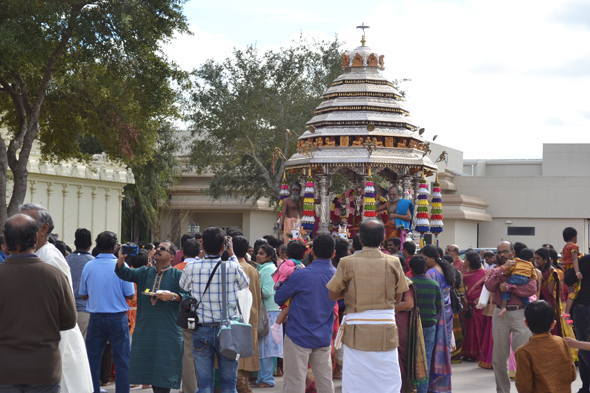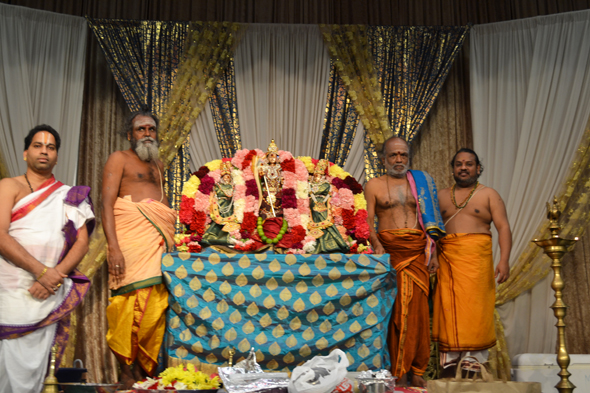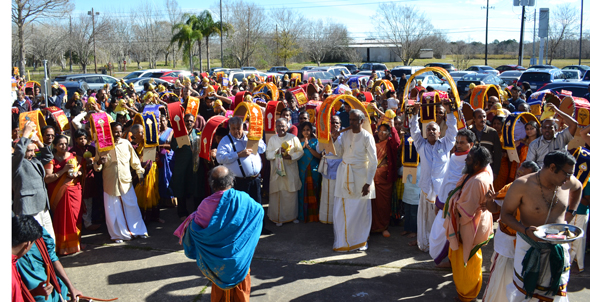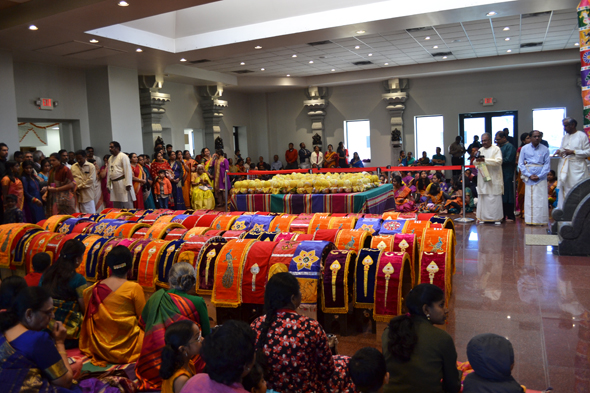Thaipoosam Celebration at Sri Meenakshi Temple
By Haripriya Sundar
PEARLAND: What an auspicious day January 24, was. More than 700 devotees came together at the Sri Meenakshi Temple to celebrate Thai Poosam. What was especially auspicious about this date is that the celebration was held on the same day as the actual holy day. But first, a quick synopsis about what Thai Poosam is:
Thai Poosam is a Hindu festival in honor of the Hindu God Karthikeya, also known as Lord Muruga. This festival commemorates the occasion of Goddess Parvathi, giving her son Lord Muruga, the “Sakthi Vel” (spear) to vanquish the demon army of Asura, Soorapadman. Thus it signifies victory of good over evil and is celebrated at all Murugan temples around the world. Thai Poosam is celebrated in the Tamil month of Thai (January/February), on the day of the star “Poosam” and around the full moon. Typically devotees fast in the morning and participate in different pooja activities in the temple. Women and children are dressed up in colorful clothing, and men wear authentic south Indian attire. Pooja activities include getting flowers, which are usually in yellow or orange, cutting vegetables, and other preparatory procedures. It is prominently celebrated by devotees from Tamil Nadu because Lord Muruga is also the God of the language Tamil.
The festivities at the Sri Meenakshi Temple began at the Ganesh Temple with a “Sankalpam” and pooja for all the “Pal Kudams” (a pot of milk with a coconut on top and covered with a yellow ornate cloth) and “Kaavadis” (a semi-circular decorated canopy made out of bamboo or wood with a wooden rod that holds together 2 small pots of brown sugar on either ends). The milk in the “Pal Kudams” and the brown sugar tied onto the “Kaavadis” are then used in the Abhishekam for Lord Muruga. Many devotees, especially young children, sang devotional songs and chanted different slokas and bhajans. It was quite a sight to see the love and devotion of devotees for Lord Muruga, and the younger generations getting involved in our festivities.
After the pooja at the Ganesh Temple, devotees gathered the Pal Kudams on their heads and Kaavadis on their shoulders. Devotees chanted different praises and names of Lord Muruga, as they made their way around the temple to the Kalyana Mandapam. The typical “Kaavadi” dance performed by priest Kalyanasundaram and other devotees at the entrance, and the youth group members’ performance on the traditional “Chendamelam” inside the hall brought the sights and sounds of the festival in Tamil Nadu to Houston. Dr. Vivek Natarjan’s discourse on the significance of the day was very informative. The priests performed the grand “Abhishekham” followed by the exquisite “Alankaram” (decorations) for the deities. The devotees continued singing songs and bhajans about Lord Muruga throughout the “Alankaram”. All devotees joined in singing the Kandha Shasti Kavasam. The grand finale was the Aarti by the priests that touched and moved the devotees profoundly. All in all the ceremony had a strong divine ambience. Volunteers distributed the milk from the “Abhishekam” and “Prasadam” bags with coconuts, oranges, and apples. Meanwhile, the “Utsava Murthi” along with his consorts Deivayanai and Valli were taken out on a procession on the silver chariot or “Ratham” to the main temple for the final Aarthi. Prasadam and “Aannadhanam” (lunch) was provided by the temple to all the devotees.
This grand celebration was made successful due to the efforts of Chairman Narayanan, event coordinators Meena Subramaniam, Dr. T.A. Dorairajan, and Malar Narayanan, the RAC team members, the incomparable MTS priests, MTS staff, and numerous dedicated volunteers.




